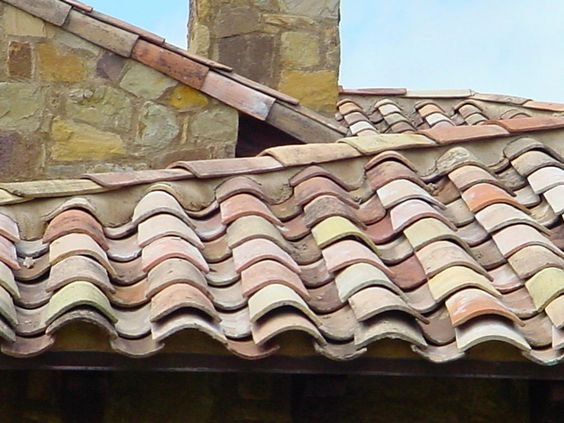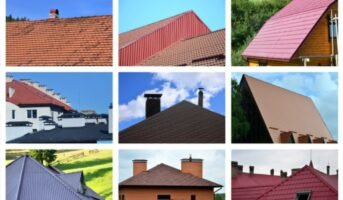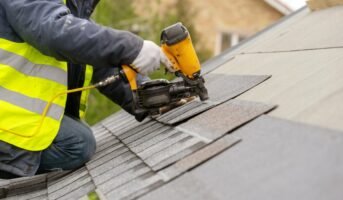Among the most essential components of a house is its roofing system. Despite the fact that there are a number of different roofing solutions available in India, shingles roofing is the most distinctive product available in the market right now, and it is also the most popular.
We will go into the intricacies of shingles roofing in this article, including its advantages and disadvantages, the many types of shingles, and the procedures to take when selecting the finest shingles for your home.
Shingles roofing: Pros and cons
Shingles may be manufactured from a wide variety of materials, each of which has its own unique set of benefits and drawbacks. Hardwood, metal, asphalt, polyester, biological materials, and a variety of other types of substances, such as those listed above, are all examples of commonly used materials.
Before you even consider the possibility of installing them in your house or place of business, you need to have a thorough understanding of both the pros and the cons associated with them.
-
Pros of shingles roofing
Shingles are one of the most often utilised roofing materials for residential properties, and the benefits that they provide are as follows:
- They do not break the bank. In comparison to the majority of other kinds of roofing, shingles are not only simple to get but also more affordable. They are offered at a range of pricing points, which contributes to their widespread appeal among a diverse selection of consumers.
- They are often used in buildings with steep slopes, the majority of which may be found in India because of the significant role that rain plays in the region.
- They are quite simple to put in place. As a result, the time required to install them is greatly decreased, which lowers the overall cost.
- Shingles are not harmful to the surrounding ecosystem. Shingles are often crafted using non-harmful and eco-friendly materials such as recycled plastic and wood waste.
- When opposed to roofs made of flat concrete, shingle roofing often has a more conventional and regal appearance, and they often come with a warranty that lasts a lifetime.
- The level of upkeep needed is not very high. They are tough, long-lasting, and very sturdy.
- They are so resistant to wear that a person walking over them won’t do any damage to them.
- They are offered in a variety of hues and patterns to choose from. You won’t have any trouble finding roofing materials that go with your colour scheme.
- Another important benefit is that it may make it easier for rainfall to run down to the ground owing to the steep slopes, which in turn prevents rainwater from pooling up on your roof and eventually seeping into your home.
- You can get class-A fire prevention from most brands.
-
Cons of shingles roofing
Before deciding to go with shingles as your roofing material of choice, you need to take into account the fact that, despite their many positive attributes, they also have a few drawbacks.
- The wind is among the roofing shingle’s worst adversaries and may cause it to get damaged. Shingles roofing may be lifted, damaged, or even torn off entirely by strong winds that are blowing at rapid speeds.
- Certain varieties of asphalt shingles are known to transfer heat into houses, which may occasionally cause the shingles to get damaged.
- The durability of shingles is often determined by the material and quality of the shingles. Roofing shingles have a lifespan that ranges anywhere from 20 to 30 years, depending on how well they are maintained.
- Dew droplets and dew accumulation in shaded sections of your roof may be another issue with shingles since they can progressively deteriorate as a result.
- The accumulation of fungus on the shingles is a symptom of the more general issue of wetness.
see also about Are fibre sheets a good roofing option?
Shingles roofing: Types
Roofing shingles come in a wide variety of designs, all of which can be purchased for a different price tag and features a different standard of excellence. As a result, it is essential to have an understanding of one’s preferences and requirements before making a choice about the roofing shingles to use. The three most common kinds of shingles used in roofing are as follows:
-
Asphalt Shingles

Source: Pinterest
This particular kind of shingles is put to use pretty often. They are used more often as a result of how readily available and inexpensive they are. They may be crafted from a wide variety of materials and can be found in a wide variety of houses and structures since they complement any style. They range in price from Rs 80 to Rs 150 per square foot, on average.
The following are some of the varieties of asphalt roofing that are the most popular among homeowners:
-
Organic roofing shingles and fibreglass shingles
Their asphalt exteriors make them quite similar to one another. It’s just the material they’re using as a foundation that’s obviously different. Fibreglass variants, as their name implies, are constructed from fibre-reinforced plastic, whereas organic variants are often constructed from wood-based materials like paper. Fibreglass shingles are more durable in hot weather, and they’re healthier for the environment since they use less asphalt. However, it does not provide the same degree of protection against the cold as organic shingles. Organic roof shingles also tend to survive longer than their synthetic counterparts.
-
Solar reflective shingles
These are Infrared-reflective shingles, and they are more reflective than standard shingles. Because of this, the internal temperatures of buildings are somewhat lower than those outside. Solar reflecting shingles have a higher upfront cost compared to standard shingles. Their per-square-foot prices are Rs 280 to 350.
-
Three-tab shingles roofing
These are just your standard asphalt shingles, and they seem flat. It’s half the weight of laminate shingles, but just as effective. Unfortunately, they are vulnerable to severe weather because of their inability to withstand high winds. They are cheaper, with prices ranging from Rs 50 to Rs 100 per square foot. Their guarantees are just 20-30 years long.
-
Architectural or laminated roofing shingles
They are constructed with a dense mat of refined asphalt serving as their substrate. This means they are superior in weight and durability to 3-tab versions. They are resistant to adverse conditions, including high winds and other elements of nature. Laminated shingles come with a guarantee of thirty to fifty years, and in some cases, even longer. Their price per square is somewhere between Rs 75 and Rs 130, making them more expensive than three-tab shingles.
-
Tile roofing shingles

Source: Pinterest
Terracotta is the material that these roof tiles are constructed of. They provide an appearance that is indigenous and conventional. They have a lower price tag in comparison to other shingles. In addition to this, they have a very low impact on the environment and may be used in lieu of asphalt and several other materials. They may be purchased at prices ranging from Rs 30 and Rs 100 per square foot.
-
Metal Roofing Shingles

Source: Pinterest
They are another popular option for roofing shingles. Commonly used materials for this kind of roof include crumpled or flat metal sheets arranged in a standing seam pattern. There are usually horizontal ribs on the edges of these flat panels. Alloys of aluminium, steel, and stainless steel-zinc are used in their production. Tile shingles are cheaper, often costing around Rs 100 and Rs 160 per square foot.
See also: Types of building materials
Shingles roofing: Choosing the best one for your roof
Choosing the right roofing shingles requires consideration of many variables. We’re going to take a look at each of them separately. Many of them will play important roles, but it is up to you to learn about them and make choices based on your own needs.
-
Cost
One of the most important considerations is the price tag attached to setup and upkeep. Before deciding on a certain brand of roofing shingles, you need to take your budget into account. Calculating how much it will cost to replace the roof entirely is an important first step. Each material and style comes at a different price. It’s wise to weigh all of your choices carefully before making a final call.
-
Warranty
Similarly to how vital it is to evaluate the price, the warranty is as crucial. You must avoid settling for a quick fix. However, a decade of coverage is standard on most shingles, and some manufacturers even provide lifelong coverage. In general, the lengthier the guarantee, the longer your roof will remain in pristine condition. It relieves you of the stress of worrying about things afterwards.
-
Type
Roofing shingles come in a wide variety of styles and materials. The good and bad of each option are equal. Shingles for roofs come in a wide variety of materials, from metal and wood to asphalt and ceramic. When deciding on a shingle type, it’s important to weigh the benefits and drawbacks of the many options available. Each material has its own unique look and feel, which may make it more or less appealing in certain settings and better suited to different types of homes and climates. All of this has to be taken into account before you settle on the shingles for the roof.
-
Colours
You may choose the hue based on how it makes you feel, how well it complements the existing colours in your home, or how it will help sell your property. In this regard, the overwhelming amount and range of colour options might make it difficult to settle on a single preference. Finding your colour preference ahead of time and consulting an expert is highly recommended when choosing a roof colour.
-
Safety
The issue of safety is an essential component. It is imperative that you prioritise using shingles that are both stable and resistant to fire. It needs to be one that’s also long-lasting and not easily broken down by the passage of time.
-
Style
Style is another part of aesthetics that may radically transform the appearance of your home, similar to the colour in this regard. Shingles come in various patterns and designs to choose from. Rooftops may take on a variety of appearances depending on their shape, which can be either flat or rectangular. It is essential that you choose the kind of roofing material in accordance with the style of your home.
-
Composition
Although the makeup of most roof shingles is fairly standard, the vast majority of firms offer roofing shingles that may be customised to meet the requirements of individual customers. As a result, you need to be knowledgeable of whether or not you want any certain composition; for instance, you require roofing to be very strong or durable.
-
Climate
The weather patterns that are prevalent in your region are also an essential consideration. You don’t want to find yourself in a situation where you have to acquire shingles roofing that is susceptible to being damaged by the weather’s normal wear and tear.
FAQs
How long does a shingle roof last?
The lifetime of various kinds of roofs might range anywhere from 15 to 30 years, as is the case with asphalt shingles. 20-50 years is the average lifespan of composite shingles. The lifespan of modified rubber shingles is thirty years.
Are thicker shingles more durable?
To achieve a more natural appearance and to conjure the appearance of more conventional roofing materials like hardwood shake and tile, the shingles are created in a variety of shapes and sizes. Because of their larger thickness, they also have a longer lifespan. A roof covered with asphalt shingles may typically be expected to survive for 50 years if architectural shingles were used in its construction.
What do shingles consist of?
Shingles may be manufactured from a wide variety of components, including timber, slate, flagstone, metals, polymer, and composite constituents such as asphalt shingles and fibre cement shingles.
Which are preferable, bright or dark shingles?
Light shingles are a better choice for installation in warmer weather since light hues have a tendency to reflect sunlight, which helps to keep your home at a lower temperature. On the other hand, dark shingles have the ability to absorb heat, making them a good choice for locations with lower average temperatures. Additionally, they have a tendency to hasten the process of snow melting.
Housing News Desk is the news desk of leading online real estate portal, Housing.com. Housing News Desk focuses on a variety of topics such as real estate laws, taxes, current news, property trends, home loans, rentals, décor, green homes, home improvement, etc. The main objective of the news desk, is to cover the real estate sector from the perspective of providing information that is useful to the end-user.
Facebook: https://www.facebook.com/housing.com/
Twitter: https://twitter.com/Housing
Email: [email protected]











